Compressive and Shear Strengths of Coir Fibre Reinforced Activated Carbon Stabilised Lateritic Soil
Abstract
:1. Introduction
2. Materials and Methods
3. Tests Results
3.1. Unconfined Compression-Strength Test
3.2. Direct Shear Test
3.3. Microstructural Analysis
3.4. Surface Area Analysis (BET)
4. Discussion
4.1. Unconfined Compressive Strength
4.2. Shear Strength
4.3. Elastic Modulus (E50)
4.4. Deformability Index (ID)
5. Conclusions
- -
- The compressive strength of soil samples enhances significantly with rising AC content and adding coir fibre. This improvement is due to effective interlocking between fibre, AC, and soil.
- -
- Adding coir fibre in AC soil improves mechanical parameters, such as peak shear strength, friction angle, cohesiveness, flexibility, and residual strength, which are key parameters in construction engineering.
- -
- Cohesions of the ACF-modified specimens are higher than the untreated specimen. AC fills micropores and porous structures during the stabilisation process. Coir fibre can fill some gaps and provide interlocking effects when dispersed equally in soil. Hence, coir fibre and AC can considerably improve soil shear strength due to increased cohesiveness and frictional angle. Therefore, these materials create a complex mixture of soil, which sudden failure decreases on the ground due to overloading.
- -
- The FESEM results of AC and ACF have presented which pores are filled with AC. Therefore, cohesiveness, compression, and shear strength have been improved, due to the materials, from the reaction between minerals and additives bonding the soil particles.
- -
- The BET data also verify that the porous structures and micropores fill with AC particles during stabilisation. Consequently, pore size and pore volume decrease in AC lateritic soil.
Author Contributions
Funding
Institutional Review Board Statement
Informed Consent Statement
Data Availability Statement
Acknowledgments
Conflicts of Interest
References
- Behnood, A.; Geotechnics, A.B.-T. Soil and Clay Stabilization with Calcium- and Non-Calcium-Based Additives: A State-of-the-Art Review of Challenges, Approaches and Techniques. Transp. Geotech. 2018, 17, 14–32. [Google Scholar] [CrossRef]
- Jairaj, C.; Prathap Kumar, M.T.; Ramesh, H.N.H.; Kumar, M.; Ramesh, H.N.H. Effect of Addition of Lime on Coir Fiber Admixed BC Soil. Innov. Infrastruct. Solut. 2020, 5, 49. [Google Scholar] [CrossRef]
- Praveen, G.V.; Kurre, P. Influence of Coir Fiber Reinforcement on Shear Strength Parameters of Cement Modified Marginal Soil Mixed with Fly Ash. Mater. Today Proc. 2020, 39, 504–507. [Google Scholar] [CrossRef]
- Mitchell, J.K.; Soga, K. Soil–Water–Chemical Interactions. In Fundamentals of Soil Behavior; Wiley: New York, NY, USA, 2005; pp. 143–171. ISBN 978-0-471-46302-3. [Google Scholar]
- Zahri, A.; Materials, A.Z.-I.C.S. An Overview of Traditional and Non Traditional Stabiliser for Soft Soil. In IOP Conference Series: Materials Science and Engineering; IOP Publishing: Bristol, UK, 2019. [Google Scholar] [CrossRef] [Green Version]
- Firoozi, A.A.; Olgun, C.G.; Firoozi, A.A.; Baghini, M.S. Fundamentals of Soil Stabilization. Int. J. Geo-Eng. 2017, 8, 26. [Google Scholar] [CrossRef] [Green Version]
- Jafer, H.; Atherton, W.; Sadique, M.; Ruddock, F.; Loffill, E. Stabilisation of Soft Soil Using Binary Blending of High Calcium Fly Ash and Palm Oil Fuel Ash. Appl. Clay Sci. 2018, 152, 323–332. [Google Scholar] [CrossRef]
- Du, Y.-J.; Bo, Y.-L.; Jin, F.; Liu, C.-Y. Durability of Reactive Magnesia-Activated Slag-Stabilized Low Plasticity Clay Subjected to Drying–Wetting Cycle. Eur. J. Environ. Civ. Eng. 2016, 20, 215–230. [Google Scholar] [CrossRef]
- Chang, I.; Im, J.; Prasidhi, A.K.; Cho, G.-C. Effects of Xanthan Gum Biopolymer on Soil Strengthening. Constr. Build. Mater. 2015, 74, 65–72. [Google Scholar] [CrossRef]
- Criado, M.; Fernández-Jiménez, A.; De La Torre, A.G.; Aranda, M.A.G.; Palomo, A. An XRD Study of the Effect of the SiO2/Na2O Ratio on the Alkali Activation of Fly Ash. Cem. Concr. Res. 2007, 37, 671–679. [Google Scholar] [CrossRef]
- Aziz, I.H.; al Bakri, M.M.A.; Cheng Yong, H.; Yun Ming, L.; Hussin, K.; Azimi, E.A. A Review on Mechanical Properties of Geopolymer Composites for High Temperature Application. In Key Engineering Materials; Trans Tech Publicashions: Stafa-Zurich, Switzerland, 2015; Volume 660, pp. 34–38. [Google Scholar]
- Anirudhan, T.S.; Sreekumari, S.S.; Bringle, C.D. Removal of Phenols from Water and Petroleum Industry Refinery Effluents by Activated Carbon Obtained from Coconut Coir Pith. Adsorption 2009, 15, 439–451. [Google Scholar] [CrossRef]
- Mukherjee, K.; Mishra, A.K. Hydro-Mechanical Properties of Sand-Bentonite-Glass Fiber Composite for Landfill Application. KSCE J. Civ. Eng. 2019, 23, 4631–4640. [Google Scholar] [CrossRef]
- Mohammadinia, A.; Disfani, M.M.; Narsilio, G.A.; Aye, L. Mechanical Behaviour and Load Bearing Mechanism of High Porosity Permeable Pavements Utilising Recycled Tire Aggregates. Constr. Build. Mater. 2018, 168, 794–804. [Google Scholar] [CrossRef]
- Mohajerani, A.; Kurmus, H.; Conti, D.; Cash, L.; Semcesen, A.; Abdurahman, M.; Rahman, M.T. Environmental Impacts and Leachate Analysis of Waste Rubber Incorporated in Construction and Road Materials: A Review. Sci. Total Environ. 2022, 835, 155269. [Google Scholar] [CrossRef] [PubMed]
- Hejazi, S.M.; Sheikhzadeh, M.; Abtahi, S.M.; Zadhoush, A. A Simple Review of Soil Reinforcement by Using Natural and Synthetic Fibers. Constr. Build. Mater. 2012, 30, 100–116. [Google Scholar] [CrossRef]
- Mohanty, A.K.; Drzal, L.T.; Group, F. Natural Fibers, Biopolymers, and Biocomposites; CRC Press: Boca Raton, FL, USA, 2005; ISBN 9780849317415. [Google Scholar]
- Valipour, M.; Shourijeh, P.T.; Mohammadinia, A. Application of Recycled Tire Polymer Fibers and Glass Fibers for Clay Reinforcement. Transp. Geotech. 2021, 27, 100474. [Google Scholar] [CrossRef]
- Han, J. Principles and Practice of Ground Improvement; John Wiley & Sons: Hoboken, NJ, USA, 2015; ISBN 1118259912. [Google Scholar]
- Jamsawang, P.; Voottipruex, P.; Horpibulsuk, S. Flexural Strength Characteristics of Compacted Cement-Polypropylene Fiber Sand. J. Mater. Civ. Eng. 2015, 27, 04014243. [Google Scholar] [CrossRef]
- Kravchenko, E.; Liu, J.; Krainiukov, A.; Chang, D. Dynamic Behavior of Clay Modified with Polypropylene Fiber under Freeze-Thaw Cycles. Transp. Geotech. 2019, 21, 100282. [Google Scholar] [CrossRef]
- Narani, S.S.; Abbaspour, M.; Mir Mohammad Hosseini, S.M.; Moghadas Nejad, F. Long-Term Dynamic Behavior of a Sandy Subgrade Reinforced by Waste Tire Textile Fibers (WTTFs). Transp. Geotech. 2020, 24, 100375. [Google Scholar] [CrossRef]
- Ranjan, G.; Vasan, R.M.; Charan, H.D. Behaviour of Plastic-Fibre-Reinforced Sand. Geotext. Geomembr. 1994, 13, 555–565. [Google Scholar] [CrossRef]
- Ramkrishnan, R.; Sruthy, M.R.; Sharma, A.; Karthik, V. Effect of Random Inclusion of Sisal Fibres on Strength Behavior and Slope Stability of Fine Grained Soils. Mater. Today Proc. 2018, 5, 25313–25322. [Google Scholar] [CrossRef]
- Cui, H.; Jin, Z.; Bao, X.; Tang, W.; Dong, B. Effect of Carbon Fiber and Nanosilica on Shear Properties of Silty Soil and the Mechanisms. Constr. Build. Mater. 2018, 189, 286–295. [Google Scholar] [CrossRef]
- Bao, X.; Huang, Y.; Jin, Z.; Xiao, X.; Tang, W.; Cui, H.; Chen, X. Experimental Investigation on Mechanical Properties of Clay Soil Reinforced with Carbon Fiber. Constr. Build. Mater. 2021, 280, 122517. [Google Scholar] [CrossRef]
- Latifi, N.; Vahedifard, F.; Ghazanfari, E.; Horpibulsuk, S.; Marto, A.; Williams, J. Sustainable Improvement of Clays Using Low-Carbon Nontraditional Additive. Int. J. Geomech. 2018, 18, 4017162. [Google Scholar] [CrossRef]
- Furuya, E.G.; Chang, H.T.; Miura, Y.; Noll, K.E. A Fundamental Analysis of the Isotherm for the Adsorption of Phenolic Compounds on Activated Carbon. Sep. Purif. Technol. 1997, 11, 69–78. [Google Scholar] [CrossRef]
- Lee, C.S.; Ong, Y.L.; Aroua, M.K.; Daud, W.M.A.W. Impregnation of Palm Shell-Based Activated Carbon with Sterically Hindered Amines for CO2 Adsorption. Chem. Eng. J. 2013, 219, 558–564. [Google Scholar] [CrossRef]
- El-Shafey, E.I.; Ali, S.N.F.; Al-Busafi, S.; Al-Lawati, H.A.J. Preparation and Characterization of Surface Functionalized Activated Carbons from Date Palm Leaflets and Application for Methylene Blue Removal. J. Environ. Chem. Eng. 2016, 4, 2713–2724. [Google Scholar] [CrossRef]
- Al-Soudany, K.; Al-Gharbawi, A.; Al-Noori, M. Improvement of Clayey Soil Characteristics by Using Activated Carbon. In MATEC Web of Conferences; EDP Sciences: Les Ulis, France, 2018; Volume 162, p. 1009. [Google Scholar]
- Mengue, E.; Mroueh, H.; Lancelot, L.; Eko, R.M. Mechanical Improvement of a Fine-Grained Lateritic Soil Treated with Cement for Use in Road Construction. J. Mater. Civ. Eng. 2017, 29, 4017206. [Google Scholar] [CrossRef]
- Yang, Y.; Wang, L.; Wendroth, O.; Liu, B.; Cheng, C.; Huang, T.; Shi, Y. Is the Laser Diffraction Method Reliable for Soil Particle Size Distribution Analysis? Soil Sci. Soc. Am. J. 2019, 83, 276–287. [Google Scholar] [CrossRef]
- Wanogho, S.; Gettinby, G.; Caddy, B. Particle-Size Distribution Analysis of Soils Using Laser Diffraction. Forensic Sci. Int. 1987, 33, 117–128. [Google Scholar] [CrossRef] [Green Version]
- Chada, N.; Romanos, J.; Hilton, R.; Suppes, G.; Burress, J.; Pfeifer, P. Activated Carbon Monoliths for Methane Storage. In APS March Meeting Abstracts; APS Physics: Las Vegas, NV, USA, 2012; Volume 2012, p. W33-012. [Google Scholar]
- Dillon, E.C., Jr.; Wilton, J.H.; Barlow, J.C.; Watson, W.A. Large Surface Area Activated Charcoal and the Inhibition of Aspirin Absorption. Ann. Emerg. Med. 1989, 18, 547–552. [Google Scholar] [CrossRef]
- Soo, Y.; Chada, N.; Beckner, M.; Romanos, J.; Burress, J.; Pfeifer, P. Adsorbed Methane Film Properties in Nanoporous Carbon Monoliths. In APS March Meeting Abstracts; APS Physics: Las Vegas, NV, USA, 2013; Volume 2013, p. M38-001. [Google Scholar]
- Eisazadeh, A.; Kassim, K.A.; Nur, H. Morphology and BET Surface Area of Phosphoric Acid Stabilized Tropical Soils. Eng. Geol. 2013, 154, 36–41. [Google Scholar] [CrossRef]
- Mitchell, J.K.; Soga, K. Fundamentals of Soil Behavior; John Wiley & Sons: Hoboken, NJ, USA, 2005; Volume 3. [Google Scholar]
- Brunauer, S.; Emmett, P.H.; Teller, E. Adsorption of Gases in Multimolecular Layers. J. Am. Chem. Soc. 1938, 60, 309–319. [Google Scholar] [CrossRef]
- Rauch, A.F.; Katz, L.E.; Liljestrand, H.M. An Analysis of the Mechanisms and Efficacy of Three Liquid Chemical Soil Stabilizers; Center for Transportation Research, The University of Texas at Austin: Austin, TX, USA, 2003. [Google Scholar]
- Jairaj, C.; Prathap Kumar, M.T.; Raghunandan, M.E. Compaction Characteristics and Strength of BC Soil Reinforced with Untreated and Treated Coir Fibers. Innov. Infrastruct. Solut. 2018, 3, 21. [Google Scholar] [CrossRef]
- Crane, R.E.; Cassidy, D.P.; Srivastava, V.J. Activated Carbon Preconditioning to Reduce Contaminant Leaching in Cement-Based Stabilisation of Soils. J. Environ. Eng. 2014, 140, 04014032. [Google Scholar] [CrossRef] [Green Version]
- Phetchuay, C.; Horpibulsuk, S.; Suksiripattanapong, C.; Chinkulkijniwat, A.; Arulrajah, A.; Disfani, M.M. Calcium Carbide Residue: Alkaline Activator for Clay–Fly Ash Geopolymer. Constr. Build. Mater. 2014, 69, 285–294. [Google Scholar] [CrossRef]
- Suksiripattanapong, C.; Horpibulsuk, S.; Chanprasert, P.; Sukmak, P.; Arulrajah, A. Compressive Strength Development in Fly Ash Geopolymer Masonry Units Manufactured from Water Treatment Sludge. Constr. Build. Mater. 2015, 82, 20–30. [Google Scholar] [CrossRef]
- Syed, M.; GuhaRay, A.; Goel, D.; Asati, K.; Peng, L. Effect of Freeze–Thaw Cycles on Black Cotton Soil Reinforced with Coir and Hemp Fibres in Alkali-Activated Binder. Int. J. Geosynth. Ground Eng. 2020, 6, 19. [Google Scholar] [CrossRef]
- Anggraini, V.; Asadi, A.; Huat, B.B.K.; Nahazanan, H. Effects of Coir Fibers on Tensile and Compressive Strength of Lime Treated Soft Soil. Measurement 2015, 59, 372–381. [Google Scholar] [CrossRef]
- Widianti, A.; Diana, W.; Hasana, M. Direct Shear Strength of Clay Reinforced with Coir Fiber. UKaRsT 2020, 4, 151–162. [Google Scholar] [CrossRef]
- Chaple, P.M.; Dhatrak, A.I. Performance of Coir Fiber Reinforced Clayey Soil. Int. J. Eng. Sci. 2013, 2, 54–64. [Google Scholar]
- Ghadakpour, M.; Choobbasti, A.J.; Kutanaei, S.S. Investigation of the Kenaf Fiber Hybrid Length on the Properties of the Cement-Treated Sandy Soil. Transp. Geotech. 2020, 22, 100301. [Google Scholar] [CrossRef]
- Kumar Dutta, R.; Khatri, V.; Khatri, V.N.; Gayathri, V. Application of Machine Learning Techniques in Predicting the Bearing Capacity of E-Shaped Footing on Layered Sand View Project Multi-Edge Shallow Skirted Footings View Project Effect of Addition of Treated Coir Fibres on the Compression Behaviour of Clay. Jordan J. Civ. Eng. 2012, 6, 2012–2476. [Google Scholar]
- Sobhan, K. Improving the Tensile Strength and Toughness of a Soil-Cement-Fly Ash Pavement Subgrade with Recycled HDPE Strips. In GeoCongress 2008: Geosustainability and Geohazard Mitigation; ASCE: Reston, VA, USA, 2008; pp. 1065–1072. [Google Scholar]
- Zare, P.P.; Sheikhi Narani, S.; Abbaspour, M.; Fahimifar, A.; Mir Mohammad Hosseini, S.M.; Zare, P.P. Experimental Investigation of Non-Stabilized and Cement-Stabilized Rammed Earth Reinforcement by Waste Tire Textile Fibers (WTTFs). Constr. Build. Mater. 2020, 260, 120432. [Google Scholar] [CrossRef]
- Kamaruddin, F.A.; Nahazanan, H.; Huat, B.K.; Anggraini, V. Improvement of Marine Clay Soil Using Lime and Alkaline Activation Stabilized with Inclusion of Treated Coir Fibre. Appl. Sci. 2020, 10, 2129. [Google Scholar] [CrossRef] [Green Version]
- Sivakumar Babu, G.L.; Vasudevan, A.K.; Sayida, M.K. Use of Coir Fibers for Improving the Engineering Properties of Expansive Soils. J. Nat. Fibers 2008, 5, 61–75. [Google Scholar] [CrossRef]
- Kafodya, I.; Okonta, F. Effects of Natural Fiber Inclusions and Pre-Compression on the Strength Properties of Lime-Fly Ash Stabilised Soil. Constr. Build. Mater. 2018, 170, 737–746. [Google Scholar] [CrossRef]
- Eisazadeh, A.; Kassim, K.A.; Nur, H. Characterization of Phosphoric Acid- and Lime-Stabilized Tropical Lateritic Clay. Environ. Earth Sci. 2011, 63, 1057–1066. [Google Scholar] [CrossRef]
- Cai, G.; Liu, S. Compaction and Mechanical Characteristics and Stabilisation Mechanism of Carbonated Reactive MgO-Stabilized Silt. KSCE J. Civ. Eng. 2017, 21, 2641–2654. [Google Scholar] [CrossRef]
- Onyelowe, K.C.; Onyia, M.E.; Van, D.B.; Baykara, H.; Ugwu, H.U. Pozzolanic Reaction in Clayey Soils for Stabilisation Purposes: A Classical Overview of Sustainable Transport Geotechnics. Adv. Mater. Sci. Eng. 2021, 2021, 6632171. [Google Scholar] [CrossRef]
- Raja, P.S.K.; Thyagaraj, T. Sulfate Effects on Sulfate-Resistant Cement–Treated Expansive Soil. Bull. Eng. Geol. Environ. 2020, 79, 2367–2380. [Google Scholar] [CrossRef]
- Board, T.R.; National Academies of Sciences and Medicine, E.; Little, D.N.; Nair, S. Recommended Practice for Stabilisation of Subgrade Soils and Base Materials; The National Academies Press: Washington, DC, USA, 2009. [Google Scholar] [CrossRef]
- Wahab, N.A.; Roshan, M.J.; Rashid, A.S.A.; Hezmi, M.A.; Jusoh, S.N.; Norsyahariati, N.D.N.; Tamassoki, S. Strength and Durability of Cement-Treated Lateritic Soil. Sustainability 2021, 13, 6430. [Google Scholar] [CrossRef]
- Tang, H.; Li, H.; Duan, Z.; Liu, C.; Wu, G.; Luo, J. Direct Shear Creep Characteristics and Microstructure of Fiber-Reinforced Soil. Adv. Civ. Eng. 2021, 2021, 8836293. [Google Scholar] [CrossRef]
- Rashid, A.S.A.; Kalatehjari, R.; Noor, N.M.; Yaacob, H.; Moayedi, H.; Sing, L.K. Relationship between Liquidity Index and Stabilized Strength of Local Subgrade Materials in a Tropical Area. Measurement 2014, 55, 231–237. [Google Scholar] [CrossRef]
- Al-Jabban, W.; Knutsson, S.; Laue, J.; Al-Ansari, N. Stabilization of Clayey Silt Soil Using Small Amounts of Petrit T. Engineering 2017, 9, 540. [Google Scholar] [CrossRef] [Green Version]
- Tan, T.; Huat, B.B.K.; Anggraini, V.; Shukla, S.K.; Nahazanan, H. Strength Behavior of Fly Ash-Stabilized Soil Reinforced with Coir Fibers in Alkaline Environment. J. Nat. Fibers 2021, 18, 1556–1569. [Google Scholar] [CrossRef]
- Park, S.S. Unconfined Compressive Strength and Ductility of Fiber-Reinforced Cemented Sand. Constr. Build. Mater. 2011, 25, 1134–1138. [Google Scholar] [CrossRef]
- Saberian, M.; Jahandari, S.; Li, J.; Zivari, F. Effect of Curing, Capillary Action, and Groundwater Level Increment on Geotechnical Properties of Lime Concrete: Experimental and Prediction Studies. J. Rock Mech. Geotech. Eng. 2017, 9, 638–647. [Google Scholar] [CrossRef]
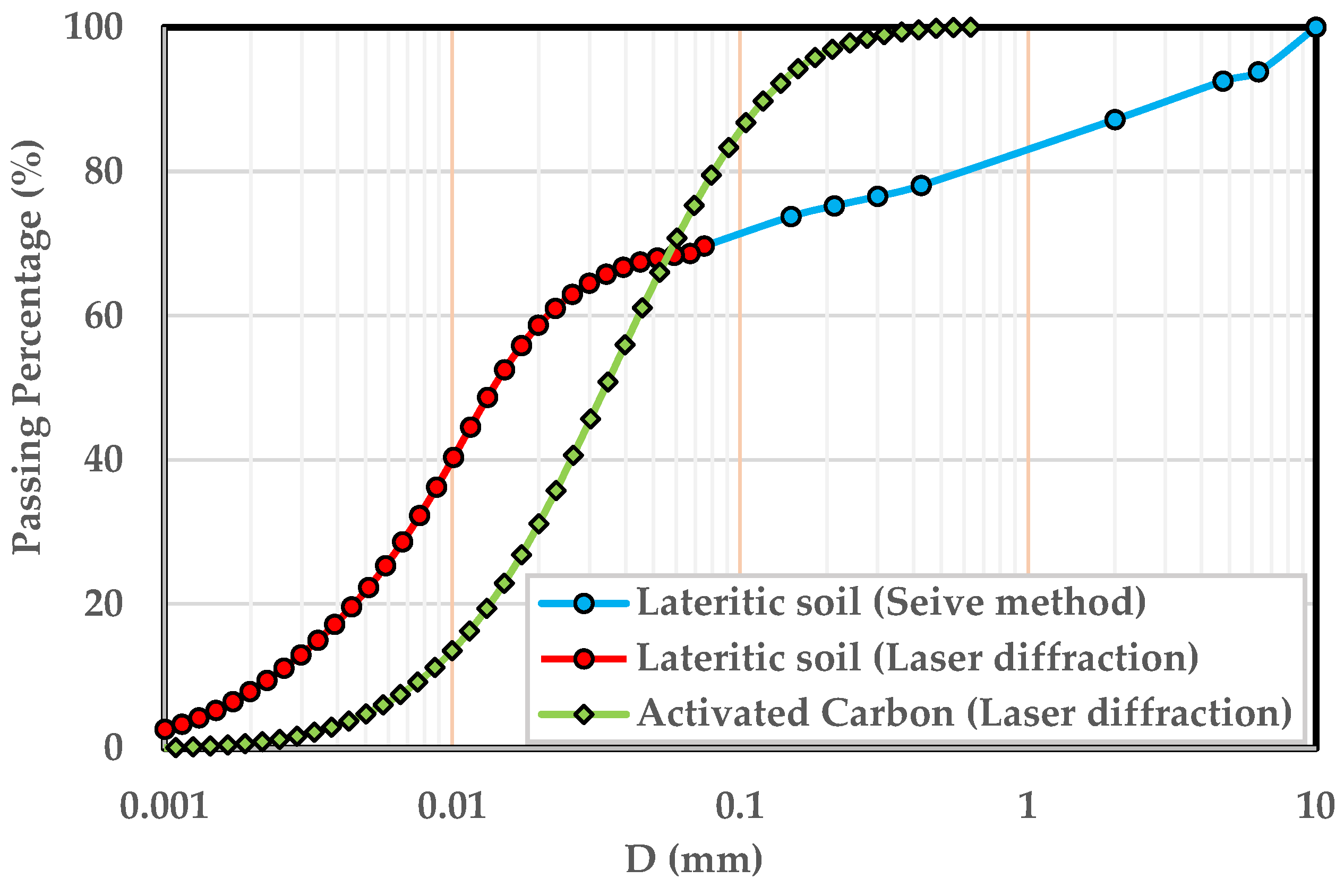
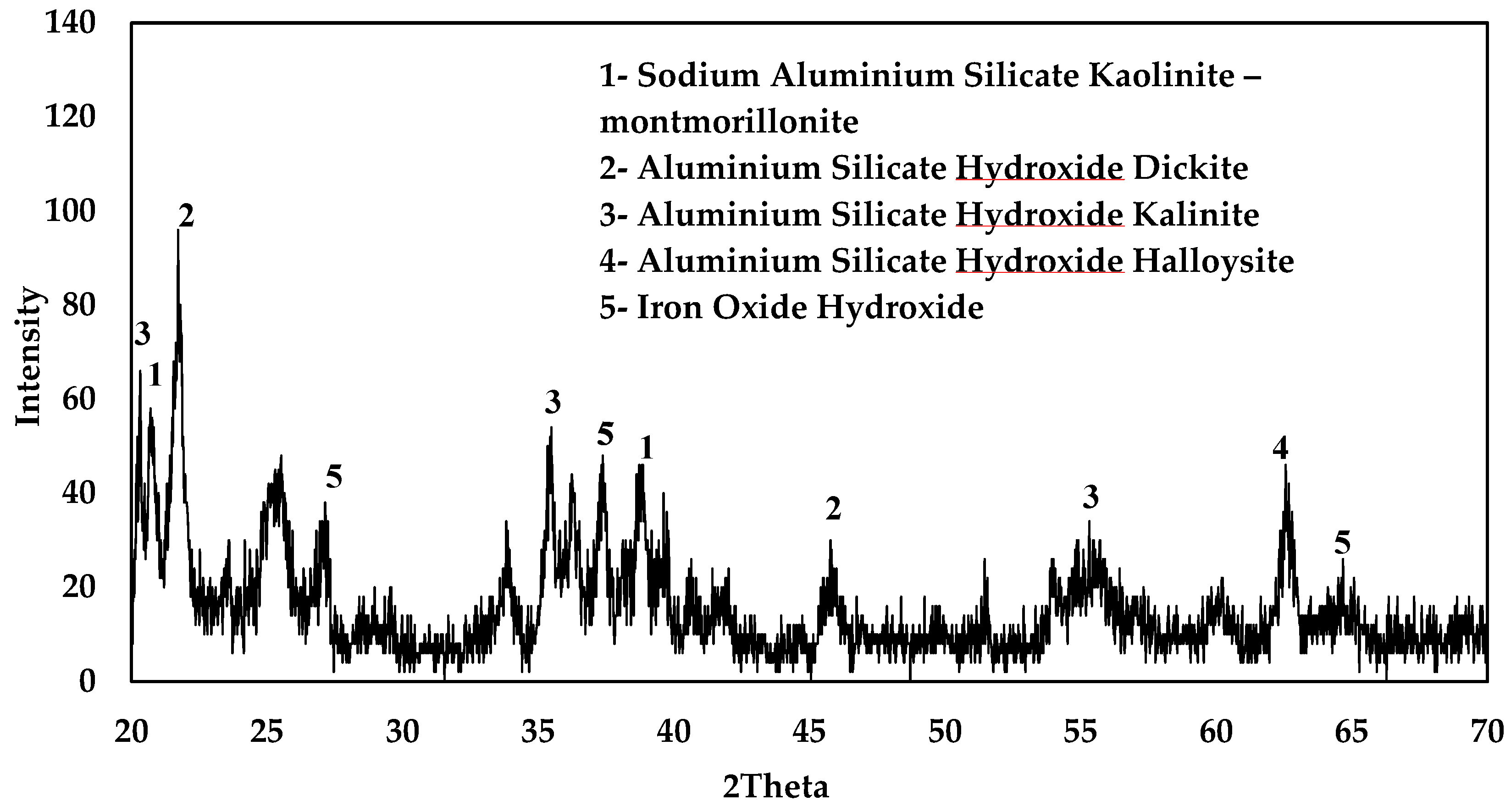
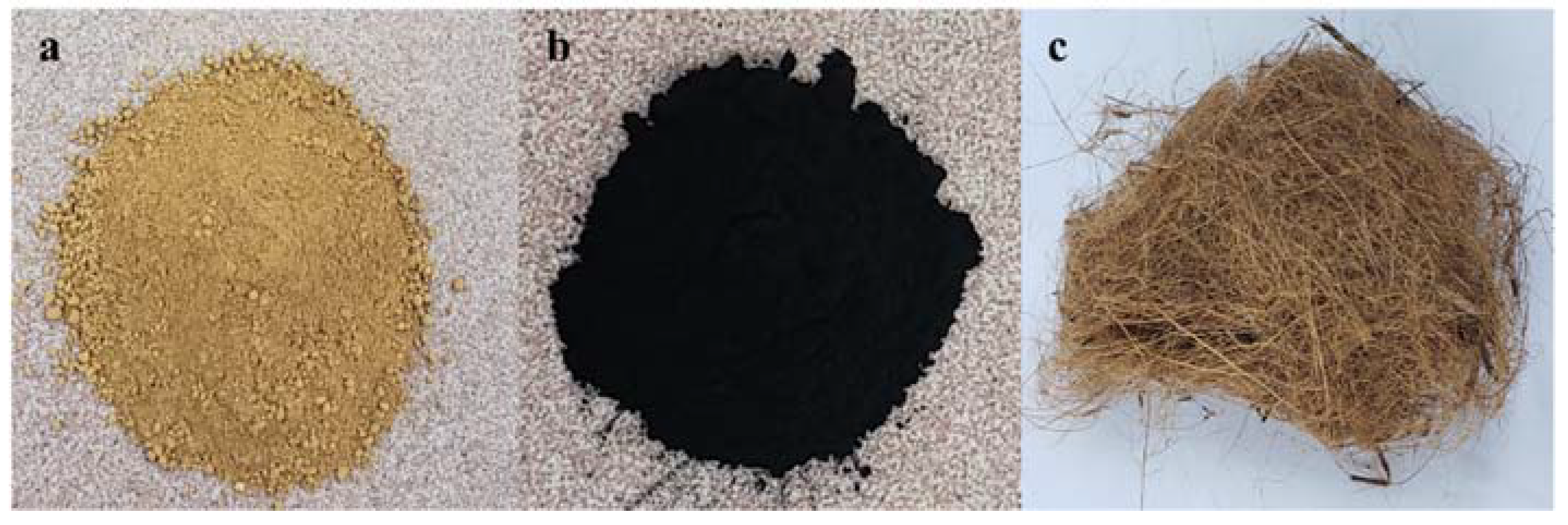


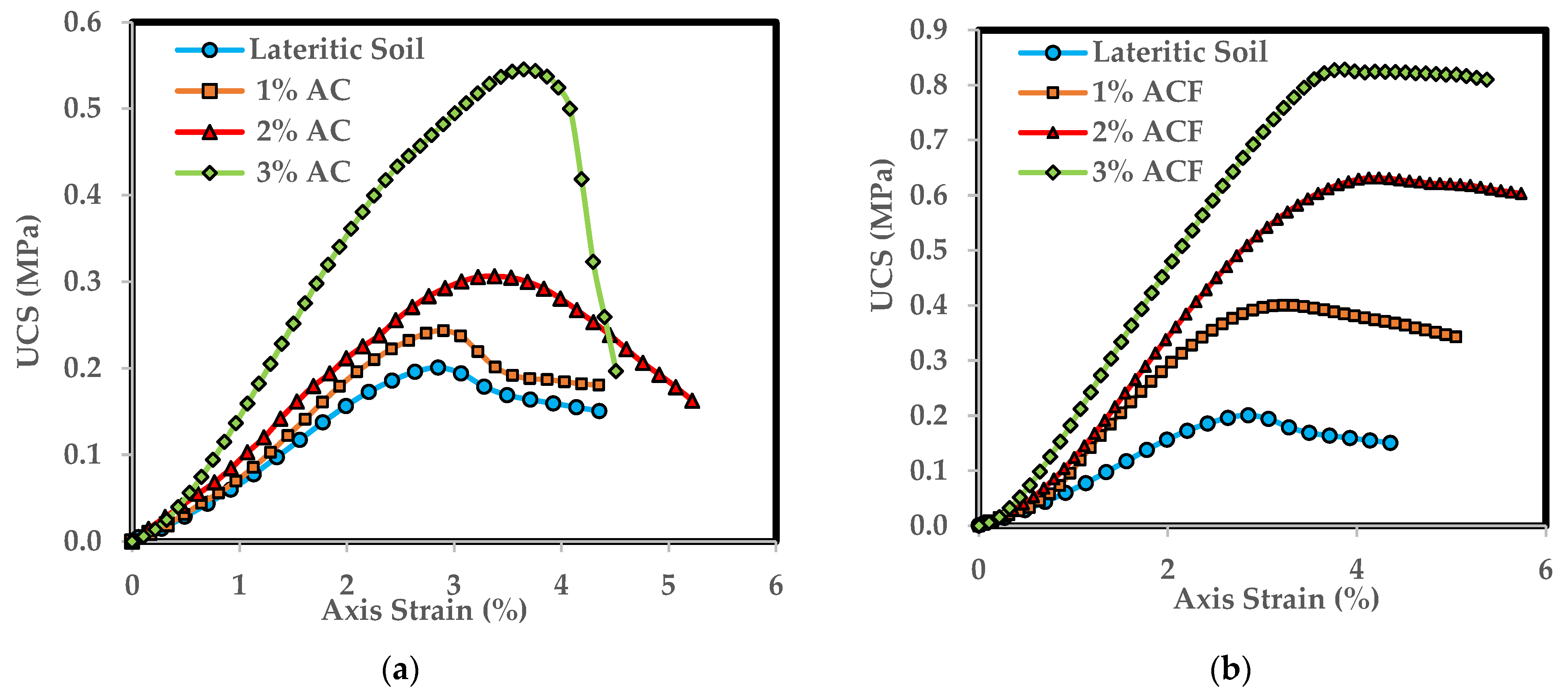

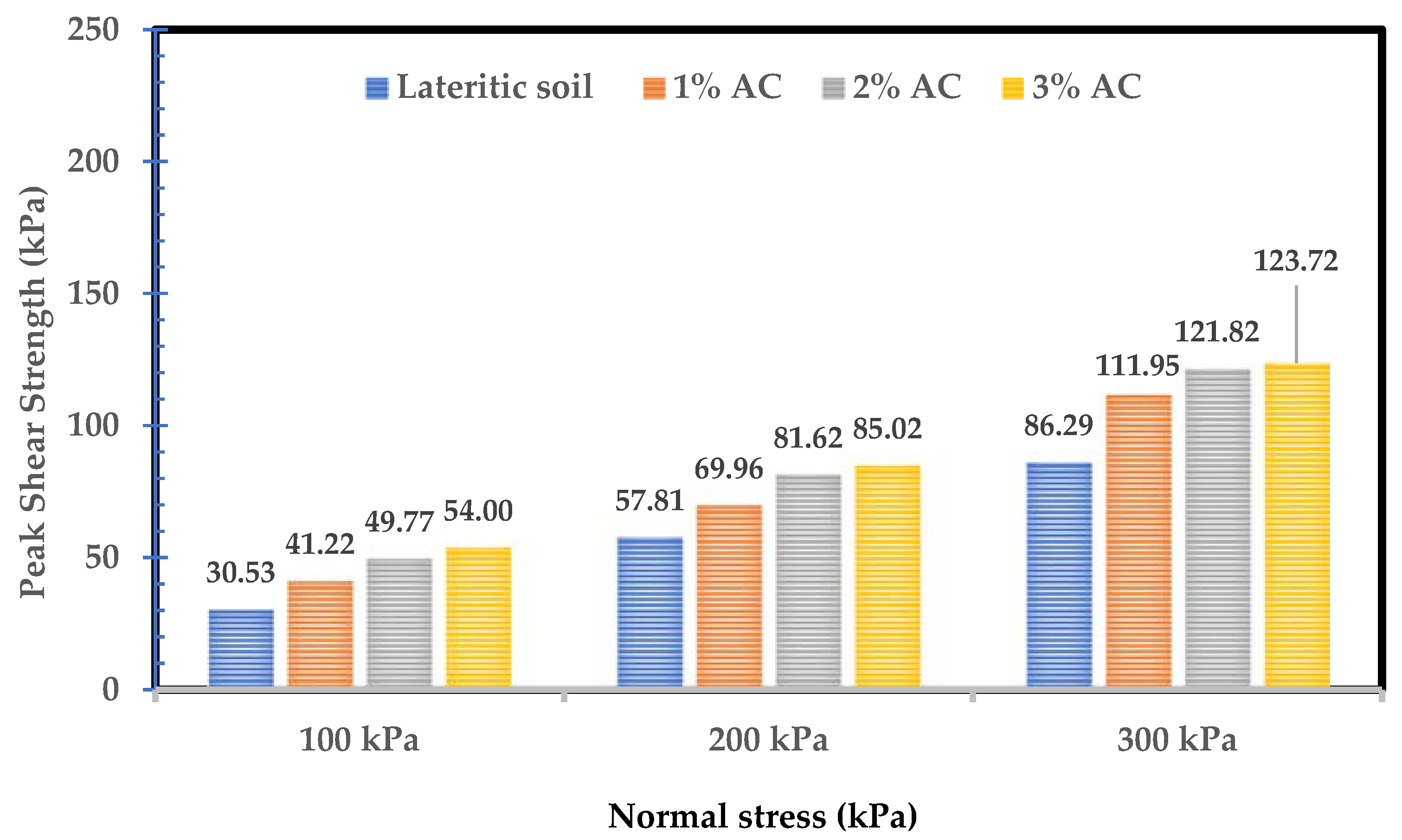
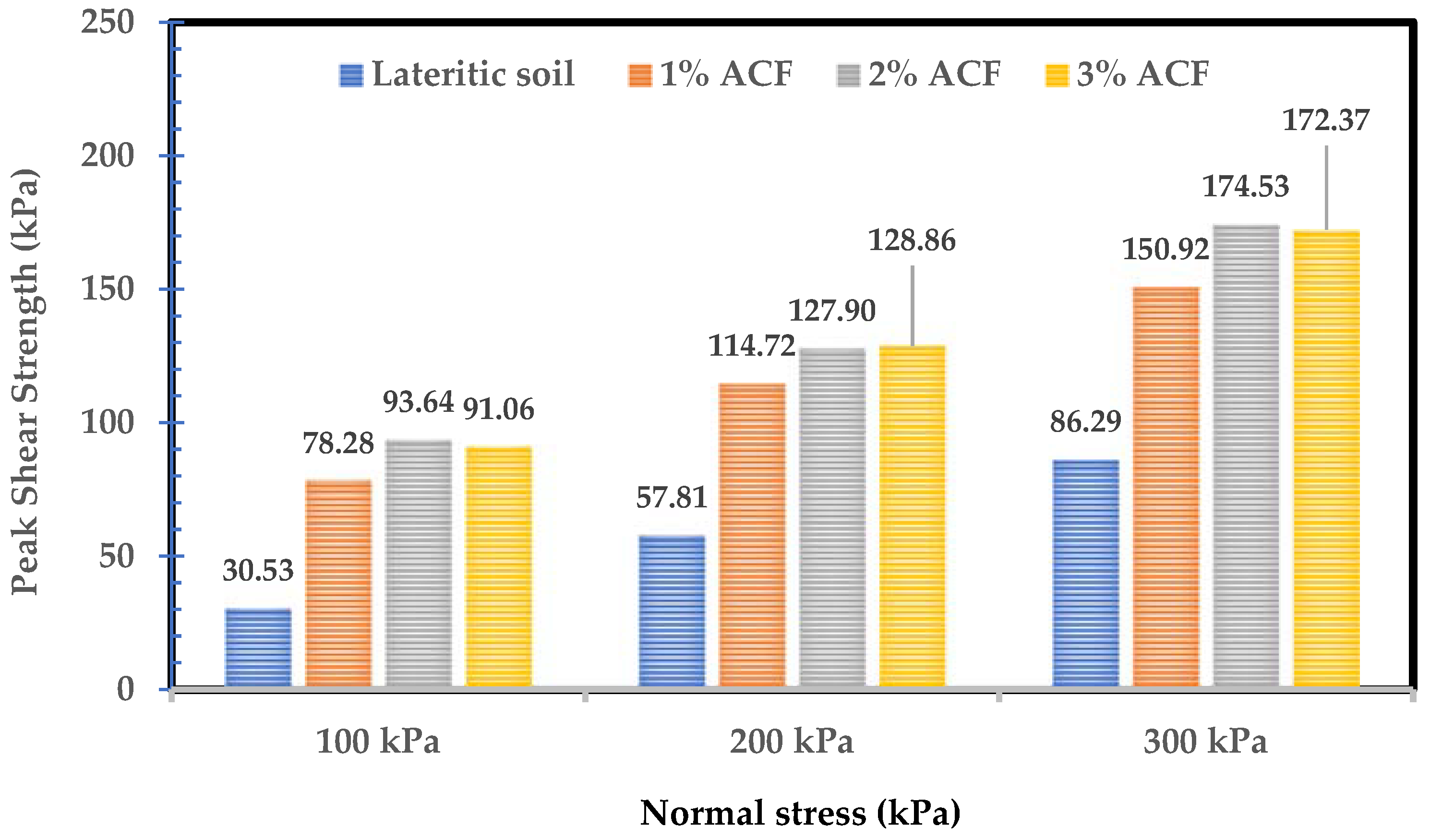

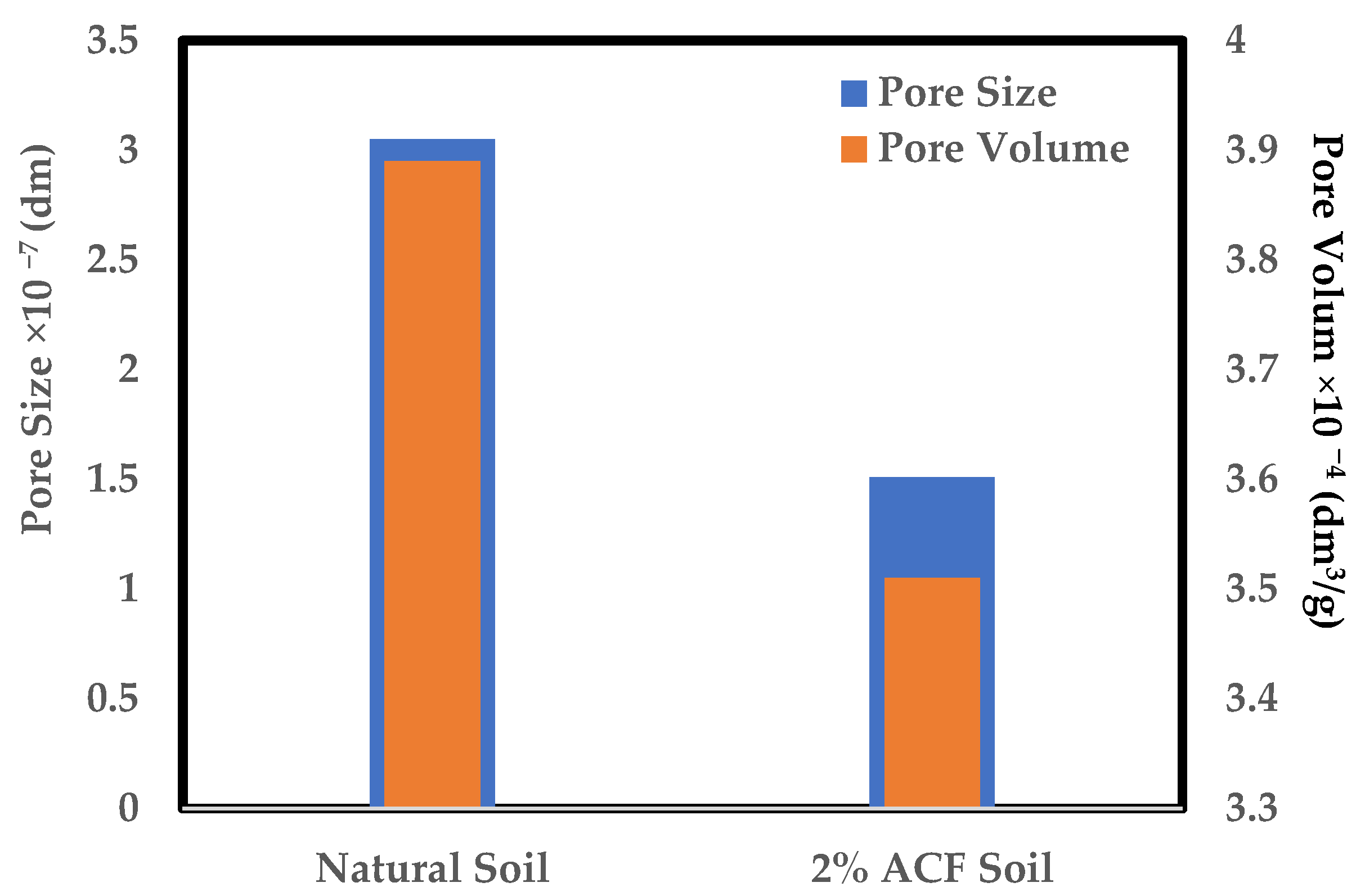
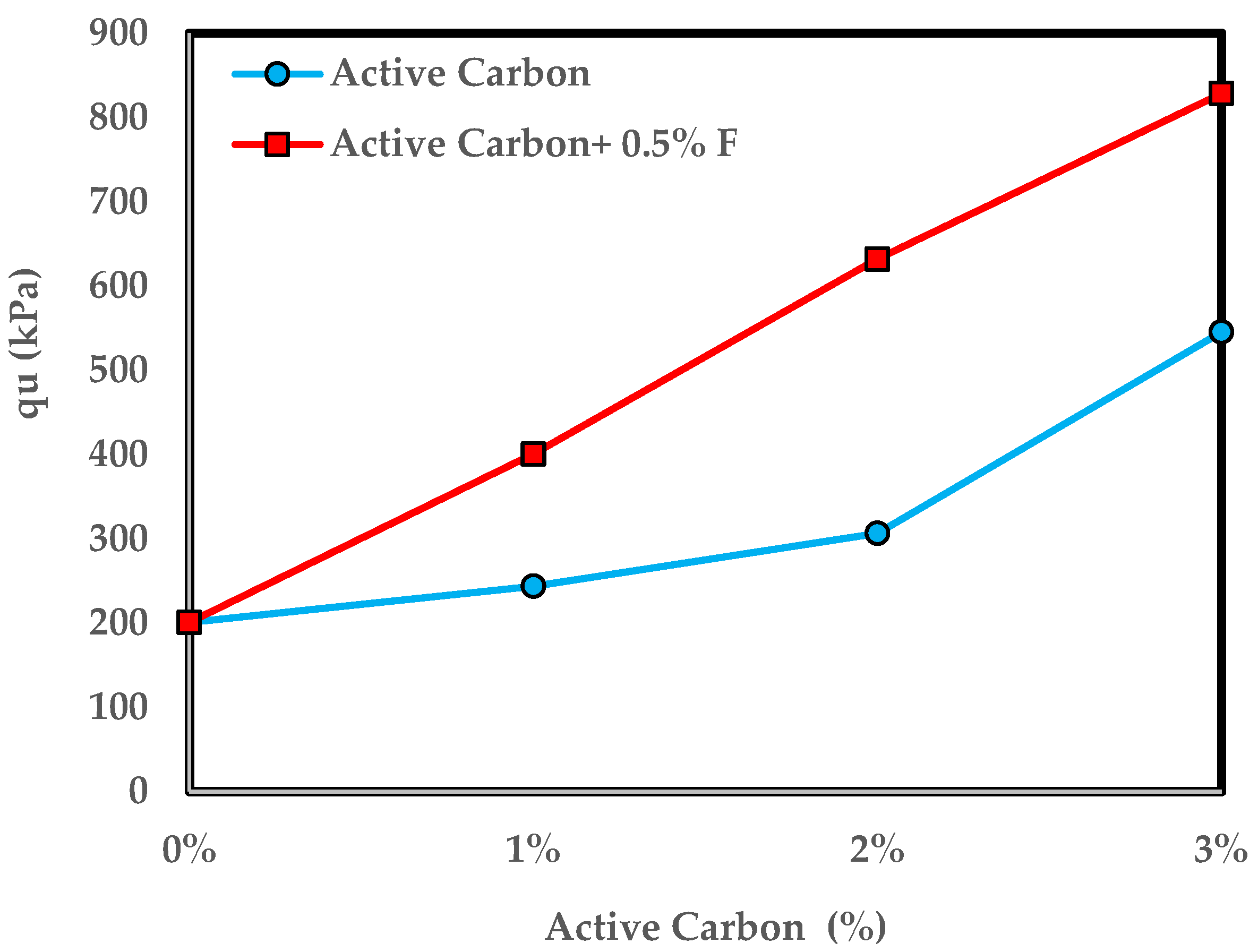
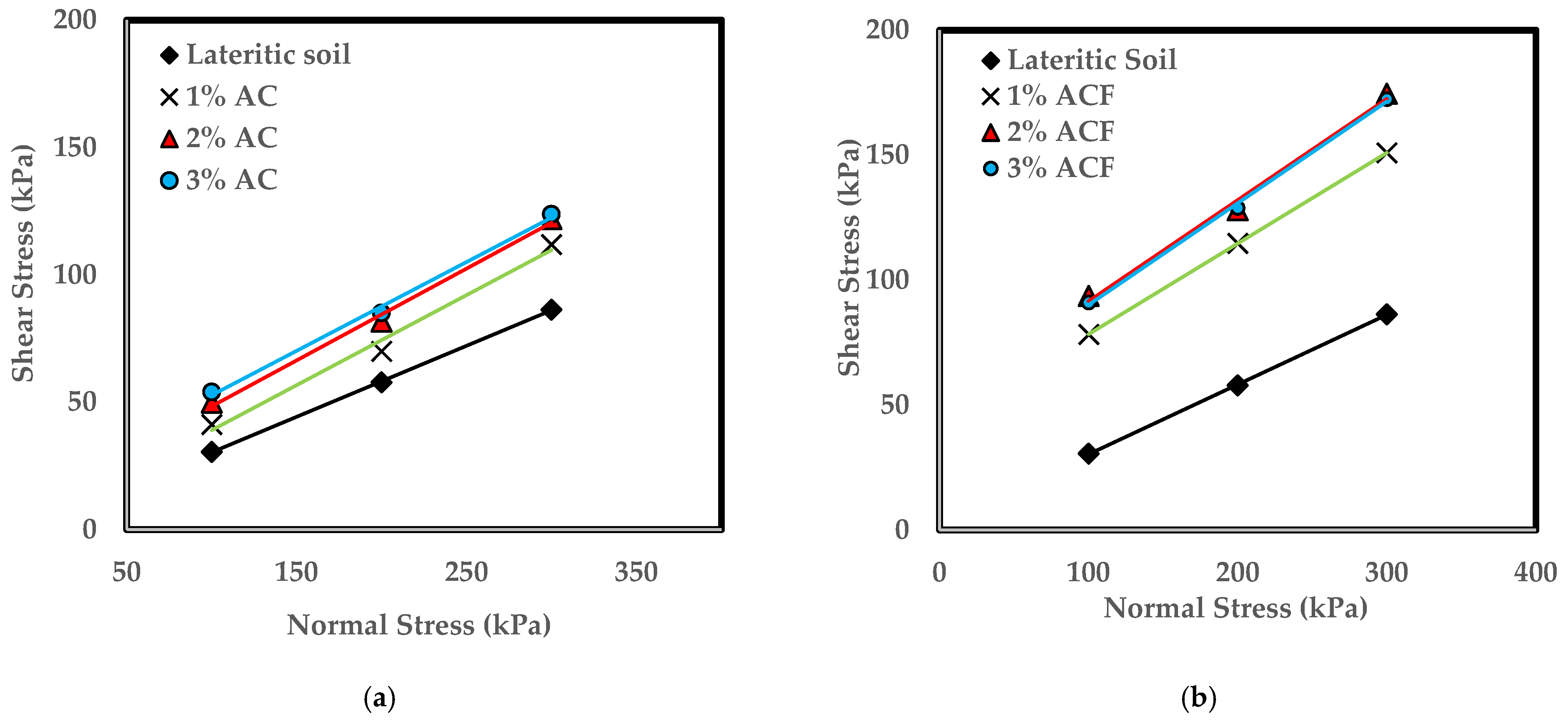
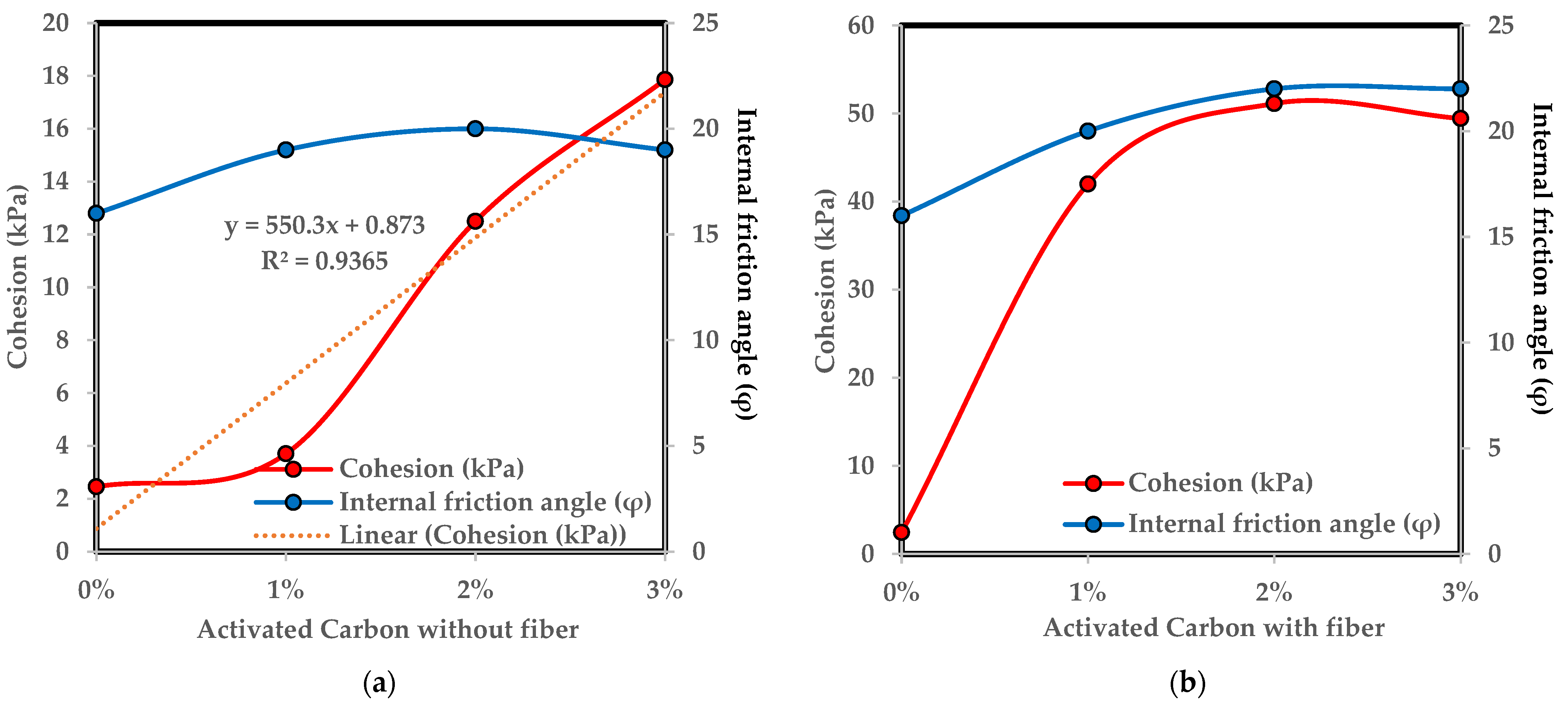
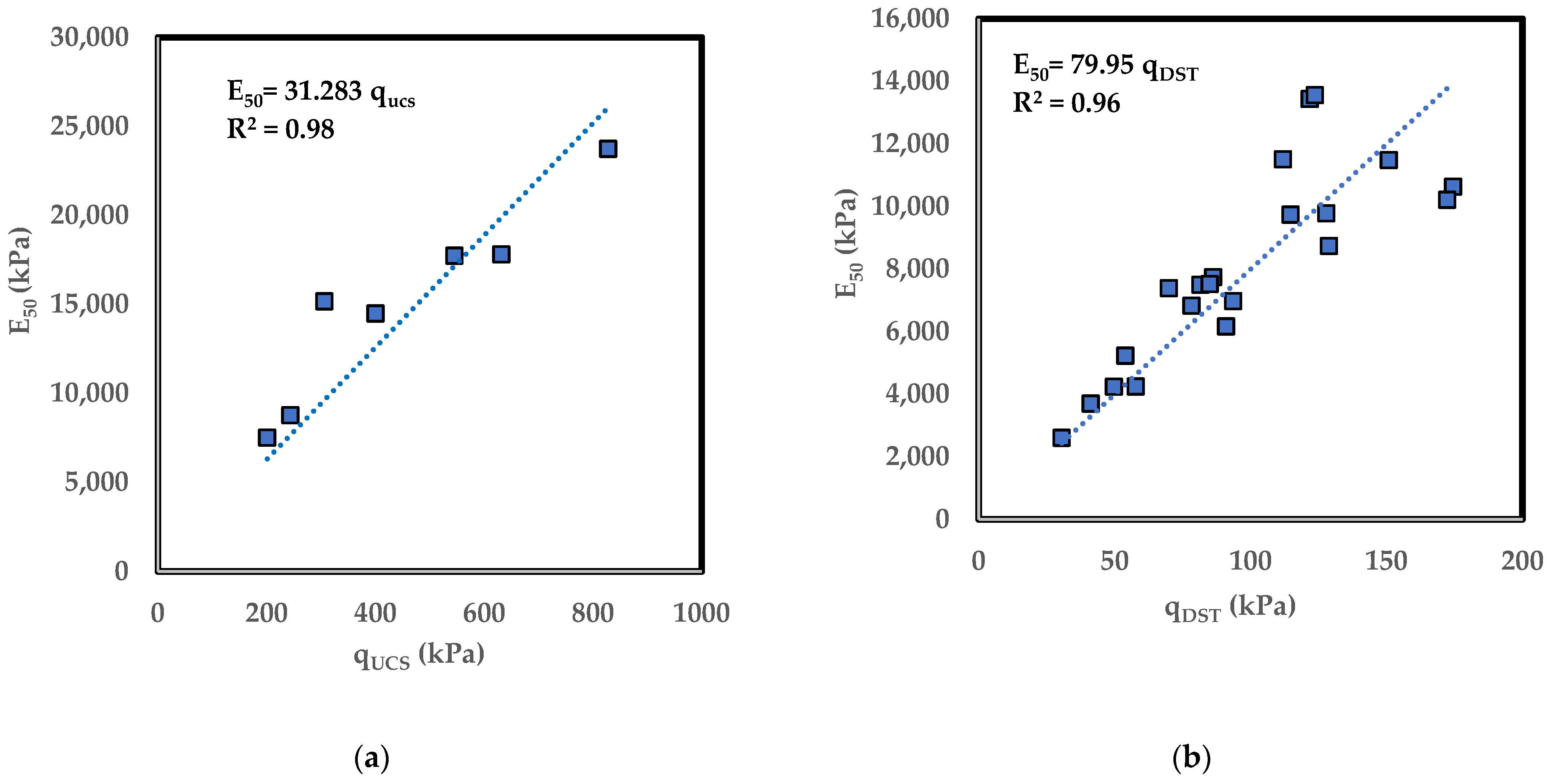
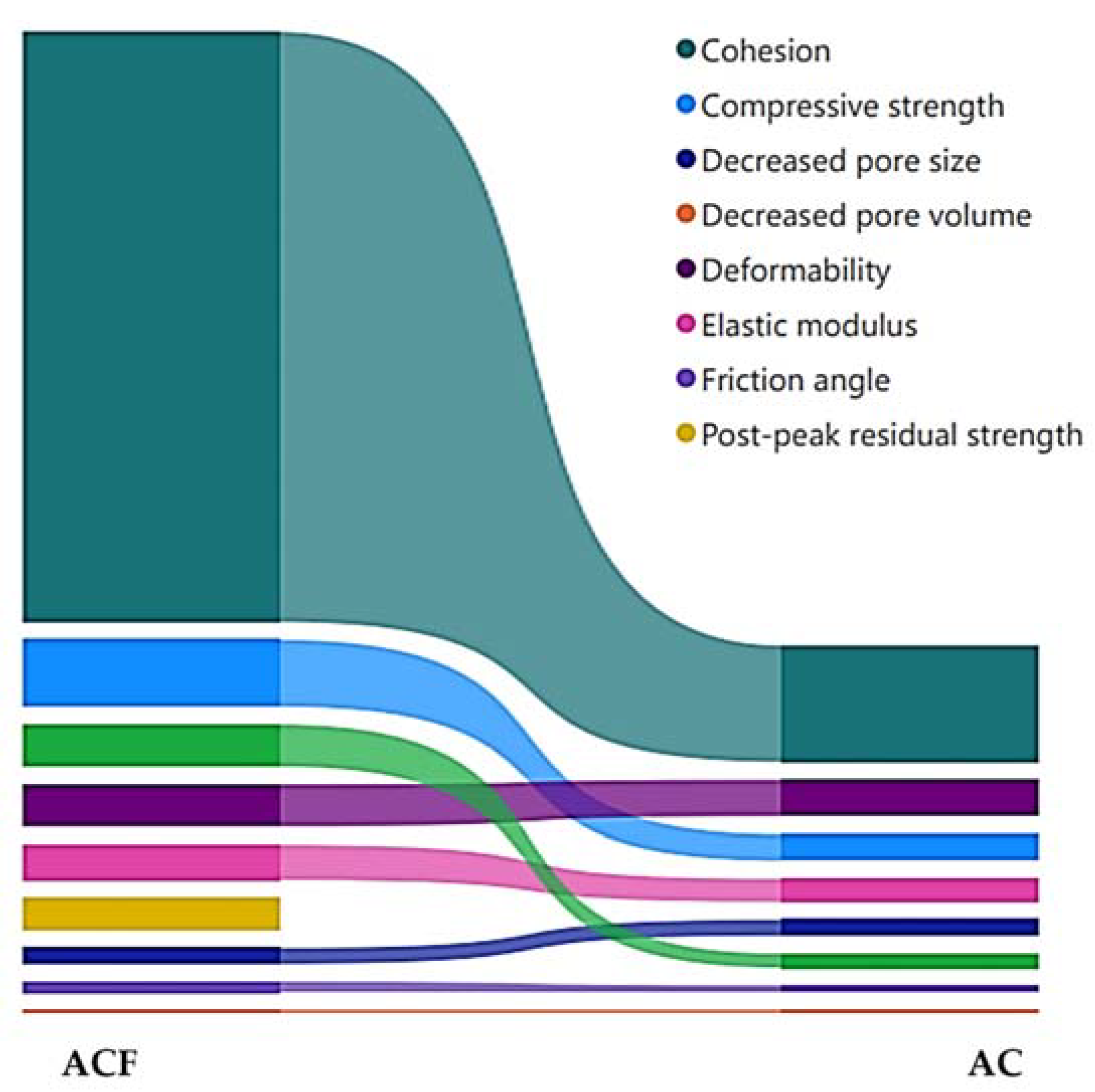
| Properties | Value | Method Standard |
|---|---|---|
| Liquid limit (LL) | 70.3% | BS 1377 |
| Plasticity index (PI) | 28.3% | |
| Gravel | 12.79% | |
| Sand | 17.54% | |
| Silt | 61.26% | |
| Clay | 8.41% | |
| Specific gravity | 2.74 | |
| Optimum moisture content | 28% | |
| pH | 4.05 |
| Composition | (%) by Weight |
|---|---|
| 39.77 | |
| 17.68 | |
| 16.62 | |
| 11.27 | |
| 7.83 | |
| 3.47 | |
| 2.57 | |
| 0.62 | |
| 0.18 |
| Mixture | E50 (kPa) | Failure Strain (%) | ID |
|---|---|---|---|
| Lateritic soil | 7515.41 | 2.85 | - |
| 1% AC | 8767.81 | 2.90 | 1.02 |
| 2% AC | 14,045.07 | 3.22 | 1.13 |
| 3% AC | 17,725.91 | 3.65 | 1.28 |
| 1% ACF | 14,480.51 | 3.22 | 1.13 |
| 2% ACF | 17,810.64 | 4.13 | 1.45 |
| 3% ACF | 23,730.22 | 3.87 | 1.36 |
Publisher’s Note: MDPI stays neutral with regard to jurisdictional claims in published maps and institutional affiliations. |
© 2022 by the authors. Licensee MDPI, Basel, Switzerland. This article is an open access article distributed under the terms and conditions of the Creative Commons Attribution (CC BY) license (https://creativecommons.org/licenses/by/4.0/).
Share and Cite
Tamassoki, S.; Daud, N.N.N.; Jakarni, F.M.; Kusin, F.M.; Rashid, A.S.A.; Roshan, M.J. Compressive and Shear Strengths of Coir Fibre Reinforced Activated Carbon Stabilised Lateritic Soil. Sustainability 2022, 14, 9100. https://doi.org/10.3390/su14159100
Tamassoki S, Daud NNN, Jakarni FM, Kusin FM, Rashid ASA, Roshan MJ. Compressive and Shear Strengths of Coir Fibre Reinforced Activated Carbon Stabilised Lateritic Soil. Sustainability. 2022; 14(15):9100. https://doi.org/10.3390/su14159100
Chicago/Turabian StyleTamassoki, Sakina, Nik Norsyahariati Nik Daud, Fauzan Mohd Jakarni, Faradiella Mohd. Kusin, Ahmad Safuan A. Rashid, and Mohammad Jawed Roshan. 2022. "Compressive and Shear Strengths of Coir Fibre Reinforced Activated Carbon Stabilised Lateritic Soil" Sustainability 14, no. 15: 9100. https://doi.org/10.3390/su14159100
APA StyleTamassoki, S., Daud, N. N. N., Jakarni, F. M., Kusin, F. M., Rashid, A. S. A., & Roshan, M. J. (2022). Compressive and Shear Strengths of Coir Fibre Reinforced Activated Carbon Stabilised Lateritic Soil. Sustainability, 14(15), 9100. https://doi.org/10.3390/su14159100









